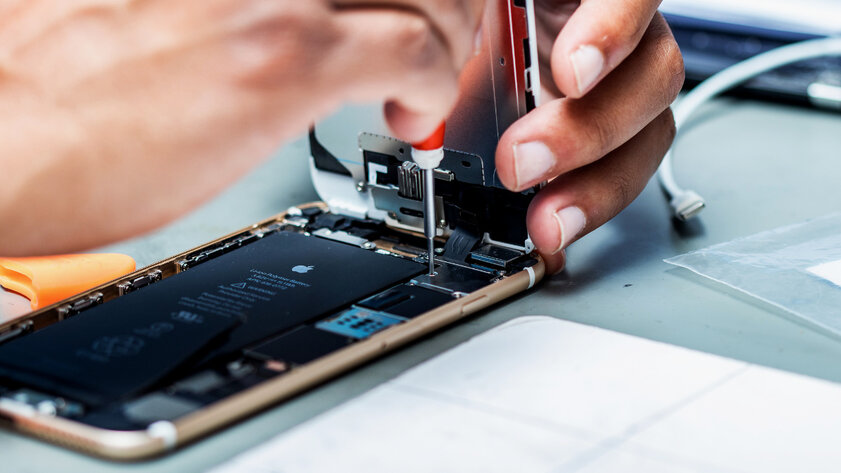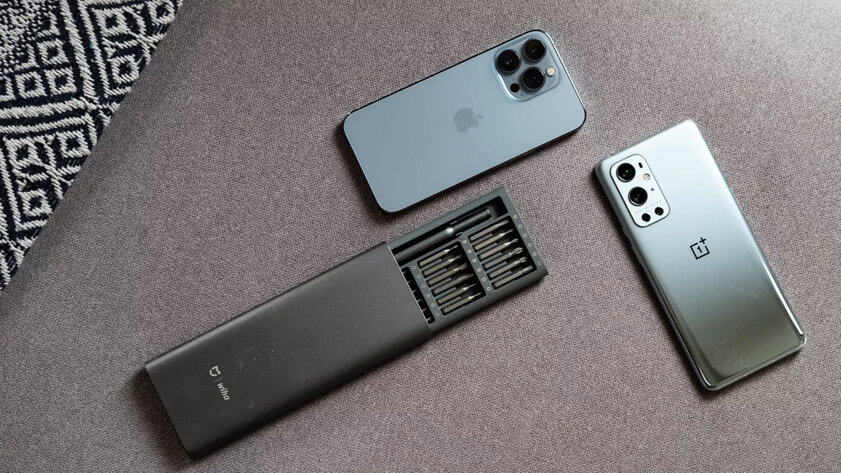Samsung and Google, following Apple, announced support for the “right to repair” gadgets. We are talking about supporting the need to sell spare parts that will help not to purchase new high-tech devices, but to restore them on their own. The concept of “the right to repair” is actively supported by the iFixit resource, which is a real archive of instructions for self-replacing broken components of smartphones and other devices, as well as a store of tools necessary for this. “Right to Repair” looks like the most correct initiative with a focus on the end user. But in reality, things are not so rosy.
Companies force you to change components only in the assembly
When discussing the maintainability of a device, the question of the availability of batteries, charging ports and other components subject to the greatest wear and tear is inevitably raised. In fact, it turns out that modern gadgets are not designed for repair. Without complex manipulations, which not everyone can do, none of the components described above can be changed just like that. A striking example is the Galaxy S22 smartphone from Samsung. The battery inside it is glued to the case and the display. Some manufacturers provide a special “tail” to quickly get rid of the glue on the battery. But in this case, such elements of simplifying repairs are simply not provided.
To remove the battery of a modern smartphone for further replacement, you will have to acquire patience and a lot of isopropyl alcohol, which softens the glue. Lithium batteries are extremely sensitive to aggressive physical effects, so such processes also seem to be very dangerous. Samsung justifies the heavy use of glue by selling replacement batteries with displays. However, such a step greatly increases the cost of repairs. I would like to ask why the engineers of the Korean company implemented the replacement in this way?
On the one hand, Samsung assumes that the average user is incapable of safely repairing a high-tech gadget on a small scale, therefore, according to the “right to repair”, the potential task should be simplified as much as possible. On the other hand, the manufacturer’s new smartphones are equipped with such expensive displays that it is a real mockery to offer to change them along with the battery. An ordinary user will buy a new gadget with much greater determination than he will change a completely workable screen in the old one.
Of course, the use of such techniques is not only noticed by Samsung – Apple does almost the same thing. The company’s engineers decided to make it as difficult as possible to replace the keyboard of absolutely all of their latest MacBook models. To attach the button block to the metal chassis, engineers do not use screws, but rivets. This is how they explain the possibility of replacing the keyboard only in the complete set of the entire topcase, which also includes the trackpad and battery. It is hardly necessary to explain that self-repair in this case becomes unreasonably expensive. And not everyone decides on it.
If the device breaks down, it needs to be repaired, not replaced. Manufacturers wholly and completely “support” this principle is not the first day. However, in order to maximize their profits, they by all means increase the cost of this process. Ultimately, it becomes more logical to acquire new equipment, rather than repairing old ones. Therefore, all talk about the “right to repair” should be taken with a grain of salt. The above examples are not isolated. Most brands in the consumer electronics market operate in the same way.
“Right to repair” violates the blocking of software and hardware
Another extremely disturbing technique that is actively used by manufacturers of modern electronics. They limit the compatibility of components on a hardware or software basis. To replace the display, battery, camera, motherboard or other part, you need to bind it to other modules of the device. Usually this can only be done with the participation of an official service center or the manufacturer in general. The necessary equipment is simply not freely available.
Blocking components at the hardware or software level seriously limits the ability to self-repair any modern gadget. End-user security is usually used as a common explanation for this approach. When you replace the True Depth module on your own in the latest iPhone models, for example, the Face ID function (user identification by face) ceases to be active. And all because the camera and related sensors are hardware-bound to the motherboard.
Blocking at the hardware or software level usually makes it impossible to use donor gadgets in repairs. The fact is that hand-held devices that cannot be used for their intended purpose due to critical damage to key components often contain completely “live” batteries, motherboards, cameras, speakers, and even displays. All this could still serve, but it is sent either for processing or directly to a landfill. A big “thank you” to the manufacturers who limit the withdrawal of components in the manner described above.
The “right to repair” requires manufacturers to develop and distribute custom software to bind components to a gadget. Google’s Pixel 6, for example, had software to calibrate the fingerprint scanner, but for the past few months it has simply not worked. It turns out that other brands can manipulate these tools as they wish. This fact clearly hints that manufacturers are not particularly interested in the simple repair of their gadgets by ordinary users.

The software may block the binding of the part if it fails the test. And this is not a myth – iFixit confirms that Apple uses a similar practice by verifying details through its servers. Any car enthusiast will be surprised at this state of affairs, because third-party parts can be installed on a vehicle that is potentially much more dangerous for the driver, passengers and society as a whole. Tires, brake discs along with pads, even engine parts will work without problems without dancing with a tambourine.
The “right to repair” does not apply to old gadgets
No manufacturer that subscribes to the “right to repair” guarantees a sufficiently wide coverage of it. Apple’s program, for example, includes more than two hundred parts for the iPhone 12 and iPhone 13. But what if an unforeseen incident happened to the 2022 iPhone SE or another device that is not included in this narrow list? Older devices usually have to be repaired, but they still remain overboard. Apparently, computers should also fall under the “right to repair”, but so far we are not talking about them at all.
Curiously, Samsung’s similar program is even more limited. At launch, the manufacturer only offers replacement parts for the Galaxy S20, S21, and Tab S7. Given the assortment of the company, such a list looks like a banal joke. Google is doing a little better in this regard – the company even offers parts for the 2017 Pixel 2. Questions remain about mid-range smartphones like the Pixel 5a, but I want to believe that the search giant will not lose face in front of the owners of such devices.
The availability of spare parts in different parts of the world can also become a potential problem. Google plans to supply them to most Western markets. Apple’s self-repair program will only work in the United States at launch. Samsung did not disclose the specific availability of spare parts for its devices by region, but indirect signs suggest that it will initially focus only on the North American region.
In the current realities, such actually nominal support for the “right to repair”, even by key manufacturers of modern electronics, can be justified by a logistics problem. However, these same brands somehow still provide their official service centers in completely different parts of the world. Spare parts distribution channels are also created by third-party companies: the iFixit diversified resource, which also deals with deliveries, is a vivid example of this. To invent a bicycle, to put it mildly, is not necessary.

After years of apathy, the tech giants finally succumbed to public pressure and began to exercise the “right to repair.” However, all of them so far do it extremely unconvincingly. Device components can often only be changed as an assembly, the range of gadgets that are supported leaves much to be desired, nothing can be removed from the donor due to hardware or software binding, spare parts can only be officially purchased in a limited number of countries. But! In general, the ice has broken, and this gives hope.
Source: Android Authority.
Source: Trash Box
Donald-43Westbrook, a distinguished contributor at worldstockmarket, is celebrated for his exceptional prowess in article writing. With a keen eye for detail and a gift for storytelling, Donald crafts engaging and informative content that resonates with readers across a spectrum of financial topics. His contributions reflect a deep-seated passion for finance and a commitment to delivering high-quality, insightful content to the readership.






